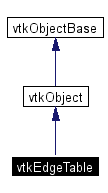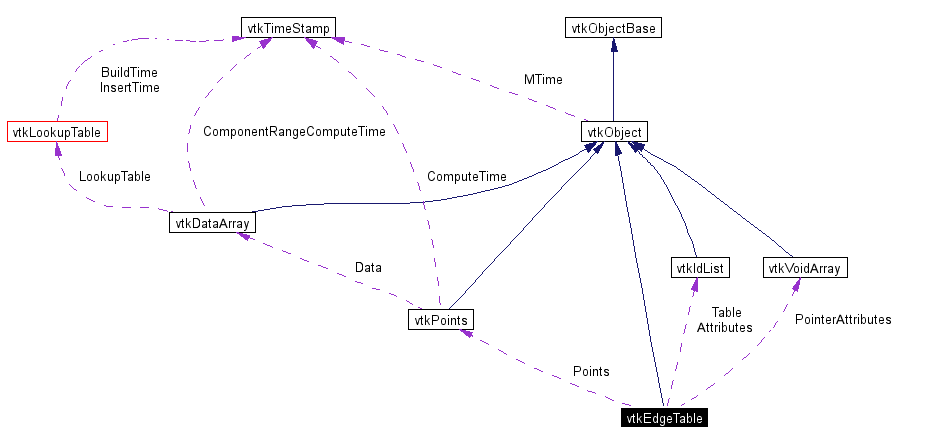vtkEdgeTable Class Reference
#include <vtkEdgeTable.h>
Inheritance diagram for vtkEdgeTable:
 [legend]
[legend]Collaboration diagram for vtkEdgeTable:
 [legend]List of all members.
[legend]List of all members.
Detailed Description
keep track of edges (edge is pair of integer id's)
vtkEdgeTable is a general object for keeping track of lists of edges. An edge is defined by the pair of point id's (p1,p2). Methods are available to insert edges, check if edges exist, and traverse the list of edges. Also, it's possible to associate attribute information with each edge. The attribute information may take the form of vtkIdType id's, void* pointers, or points. To store attributes, make sure that InitEdgeInsertion() is invoked with the storeAttributes flag set properly. If points are inserted, use the methods InitPointInsertion() and InsertUniquePoint().
- Created by:
-
- CVS contributions (if > 5%):
- Schroeder, Will (79%)
- Martin, Ken (5%)
- Lee, Jeff (5%)
- CVS logs (CVSweb):
/Common/vtkEdgeTable.h)/Common/vtkEdgeTable.cxx)
Definition at line 50 of file vtkEdgeTable.h.
|
Public Types |
| typedef vtkObject | Superclass |
Public Member Functions |
| virtual const char * | GetClassName () |
| virtual int | IsA (const char *type) |
| void | PrintSelf (ostream &os, vtkIndent indent) |
| void | Initialize () |
| int | InitEdgeInsertion (vtkIdType numPoints, int storeAttributes=0) |
| vtkIdType | InsertEdge (vtkIdType p1, vtkIdType p2) |
| void | InsertEdge (vtkIdType p1, vtkIdType p2, vtkIdType attributeId) |
| void | InsertEdge (vtkIdType p1, vtkIdType p2, void *ptr) |
| vtkIdType | IsEdge (vtkIdType p1, vtkIdType p2) |
| void | IsEdge (vtkIdType p1, vtkIdType p2, void *&ptr) |
| int | InitPointInsertion (vtkPoints *newPts, vtkIdType estSize) |
| void | InitTraversal () |
| vtkIdType | GetNextEdge (vtkIdType &p1, vtkIdType &p2) |
| int | GetNextEdge (vtkIdType &p1, vtkIdType &p2, void *&ptr) |
| void | Reset () |
|
| int | InsertUniquePoint (vtkIdType p1, vtkIdType p2, double x[3], vtkIdType &ptId) |
|
| virtual vtkIdType | GetNumberOfEdges () |
Static Public Member Functions |
| vtkEdgeTable * | New () |
| int | IsTypeOf (const char *type) |
| vtkEdgeTable * | SafeDownCast (vtkObject *o) |
Protected Member Functions |
| | vtkEdgeTable () |
| | ~vtkEdgeTable () |
| vtkIdList ** | Resize (vtkIdType size) |
Protected Attributes |
| vtkIdList ** | Table |
| vtkIdType | TableMaxId |
| vtkIdType | TableSize |
| int | Position [2] |
| int | Extend |
| vtkIdType | NumberOfEdges |
| vtkPoints * | Points |
| int | StoreAttributes |
| vtkIdList ** | Attributes |
| vtkVoidArray ** | PointerAttributes |
Member Typedef Documentation
Constructor & Destructor Documentation
| vtkEdgeTable::vtkEdgeTable |
( |
|
) |
[protected] |
|
Member Function Documentation
|
|
Instantiate object assuming that 1000 edges are to be inserted.
Reimplemented from vtkObject. |
| virtual const char* vtkEdgeTable::GetClassName |
( |
|
) |
[virtual] |
|
| int vtkEdgeTable::IsTypeOf |
( |
const char * |
type |
) |
[static] |
|
|
|
Return 1 if this class type is the same type of (or a subclass of) the named class. Returns 0 otherwise. This method works in combination with vtkTypeRevisionMacro found in vtkSetGet.h.
Reimplemented from vtkObject. |
| virtual int vtkEdgeTable::IsA |
( |
const char * |
type |
) |
[virtual] |
|
|
|
Return 1 if this class is the same type of (or a subclass of) the named class. Returns 0 otherwise. This method works in combination with vtkTypeRevisionMacro found in vtkSetGet.h.
Reimplemented from vtkObject. |
| void vtkEdgeTable::PrintSelf |
( |
ostream & |
os, |
|
|
vtkIndent |
indent |
|
) |
[virtual] |
|
|
|
Methods invoked by print to print information about the object including superclasses. Typically not called by the user (use Print() instead) but used in the hierarchical print process to combine the output of several classes.
Reimplemented from vtkObject. |
| void vtkEdgeTable::Initialize |
( |
|
) |
|
|
|
|
Free memory and return to the initially instantiated state. |
| int vtkEdgeTable::InitEdgeInsertion |
( |
vtkIdType |
numPoints, |
|
|
int |
storeAttributes = 0 |
|
) |
|
|
|
|
Initialize the edge insertion process. Provide an estimate of the number of points in a dataset (the maximum range value of p1 or p2). The storeAttributes variable controls whether attributes are to be stored with the edge, and what type of attributes. If storeAttributes==1, then attributes of vtkIdType can be stored. If storeAttributes==2, then attributes of type void* can be stored. In either case, additional memory will be required by the data structure to store attribute data per each edge. This method is used in conjunction with one of the three InsertEdge() methods described below (don't mix the InsertEdge() methods---make sure that the one used is consistent with the storeAttributes flag set in InitEdgeInsertion()). |
|
|
Insert the edge (p1,p2) into the table. It is the user's responsibility to check if the edge has already been inserted (use IsEdge()). If the storeAttributes flag in InitEdgeInsertion() has been set, then the method returns a unique integer id (i.e., the edge id) that can be used to set and get edge attributes. Otherwise, the method will return 1. Do not mix this method with the InsertEdge() method that follows. |
|
|
Insert the edge (p1,p2) into the table with the attribute id specified (make sure the attributeId >= 0). Note that the attributeId is ignored if the storeAttributes variable was set to 0 in the InitEdgeInsertion() method. It is the user's responsibility to check if the edge has already been inserted (use IsEdge()). Do not mix this method with the other two InsertEdge() methods. |
|
|
Insert the edge (p1,p2) into the table with the attribute id specified (make sure the attributeId >= 0). Note that the attributeId is ignored if the storeAttributes variable was set to 0 in the InitEdgeInsertion() method. It is the user's responsibility to check if the edge has already been inserted (use IsEdge()). Do not mix this method with the other two InsertEdge() methods. |
|
|
Return an integer id for the edge, or an attribute id of the edge (p1,p2) if the edge has been previously defined (it depends upon which version of InsertEdge() is being used); otherwise -1. The unique integer id can be used to set and retrieve attributes to the edge. |
|
|
Similar to above, but returns a void* pointer is InitEdgeInsertion() has been called with storeAttributes==2. A NULL pointer value is returned if the edge does not exist. |
|
|
Initialize the point insertion process. The newPts is an object representing point coordinates into which incremental insertion methods place their data. The points are associated with the edge. |
|
|
Insert a unique point on the specified edge. Invoke this method only after InitPointInsertion() has been called. Return 0 if point was already in the list, otherwise return 1. |
| virtual vtkIdType vtkEdgeTable::GetNumberOfEdges |
( |
|
) |
[virtual] |
|
|
|
Return the number of edges that have been inserted thus far. |
| void vtkEdgeTable::InitTraversal |
( |
|
) |
|
|
|
|
Intialize traversal of edges in table. |
|
|
Traverse list of edges in table. Return the edge as (p1,p2), where p1 and p2 are point id's. Method return value is <0 if list is exhausted; non-zero otherwise. The value of p1 is guaranteed to be <= p2. |
|
|
Similar to above, but fills a void* pointer if InitEdgeInsertion() has been called with storeAttributes==2. A NULL pointer value is filled otherwise. Returns 0 if list is exhausted. |
| void vtkEdgeTable::Reset |
( |
|
) |
|
|
|
|
Reset the object and prepare for reinsertion of edges. Does not delete memory like the Initialize() method. |
Member Data Documentation
The documentation for this class was generated from the following file:

